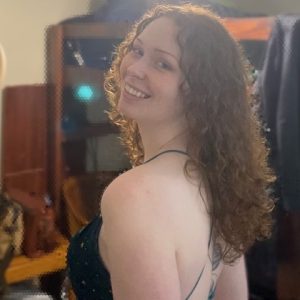Fall 2024 Fellows
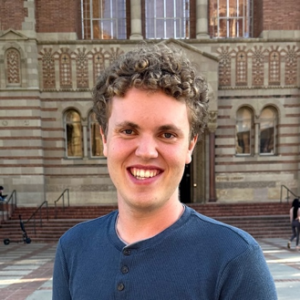
Havyn Ancelin (UCLA) is a graduate student working on the CMS experiment. His recent work has been on the Phase 2 upgrades for the L1GMT, designing and implementing improved muon reconstruction algorithms. He also enjoys tennis, swimming, board games, and playing trumpet.
|
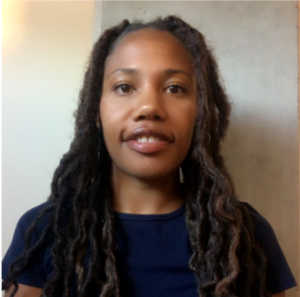
Alyssa Johnson is a Ph.D. student in Astronomy & Astrophysics at UC San Diego. They earned their bachelor’s degree in Physics from Cal Poly Humboldt, as well as previously earning an MFA and a BFA in Painting & Drawing from The Ohio State University and Temple University, respectively. Their current research is with UCSD’s Cosmology Group, where they study TES detector non-idealities to understand their effects on the Simons Observatory’s Small Aperture Telescope science products. Outside the lab, Alyssa enjoys surfing, biking, traveling, and eating out.
Samantha Kelly is a Ph.D. student in Physics at UC Davis. She earned her bachelor’s degrees in Physics and Mathematics at UC Berkeley. She is working with Dr. Matthew Citron at UC Davis on the use of scintillator-based detectors to search for millicharged particles. Current collaborations include FORMOSA, MilliQan, LANSCE-mQ. In her free time, she enjoys board/video games and playing bass.
|
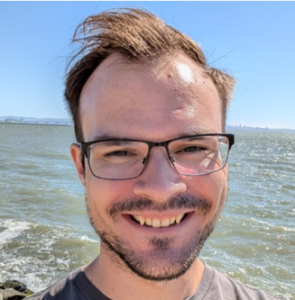
Ryan Milton is a PhD student at UC Riverside. He earned his bachelor’s degree in physics at UCLA. He is working with Dr. Miguel Arratia at UCR and Dr. Benjamin Nachman at LBNL on the development of machine learning reconstruction for calorimeters at the Electron-Ion Collider and on ML-based unbinned unfolding for collider data. In his free time, Ryan enjoys playing video games, cooking, reading public transportation documents, and feeding the local stray cats. |
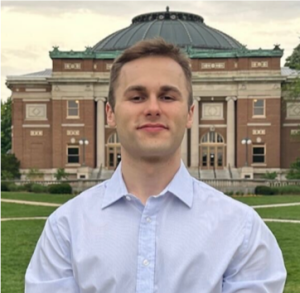
Aras Repond is a student at University of California Riverside. He did his undergraduate education at University of Illinois Urbana Champaign where he received a bachelors in physics with a minor in mathematics. Currently he is working in Professor Shawn Westerdale’s research group on developing silicon photomultiplier readout electronics. Through HEPCAT, he aims to develop a scalable array of vacuum ultraviolet silicon photomultipliers, which would satisfy the requirements for low background experiments, such as DarkSide-20K. In his spare time, he likes to stay active by lifting weights and hiking.
|
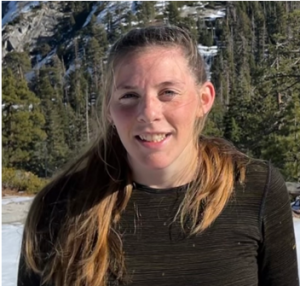
Mirella Vassilev is a graduate student in Physics at Stanford University. She earned her B.S. in Physics at Rice University in 2021. Mirella currently works at SLAC in the ATLAS group with Caterina Vernieri. With the HEPCAT fellowship, Mirella works on Monolithic Active Pixel Sensors (MAPS) for future colliders. In her free time, she enjoys windsurfing, languages, and sailing.
|
Fall 2023 Fellows
 Alexander Antonakis is a Ph.D. student in Physics at UC Santa Barbara. He earned his bachelor’s degree in Physics from the University of Michigan. Now, he is continuing his research in experimental neutrino physics under Dr. Caratelli at UCSB. His current work consists of a few different projects for the new SBND detector at Fermilab. Under the HEPCAT fellowship, Alexander will aid in building a GArTPC detector with GEM-based readout electronics to explore our abilities to resolve O(10-100) um tracks originating from O(10 -100s) keV sources. In addition, he will be investigating charge amplification in LAr through the LArCADe project in collaboration with colleagues at Fermilab to increase the scope of single-phase LArTPC detectors to be sensitive to nuclear recoil ionization signatures. The goal of these efforts is in developing novel detection methods for probing weak signatures originating from sources such as CEvNS. Outside of research, Alexander enjoys playing soccer and longboarding in his free time. Alexander Antonakis is a Ph.D. student in Physics at UC Santa Barbara. He earned his bachelor’s degree in Physics from the University of Michigan. Now, he is continuing his research in experimental neutrino physics under Dr. Caratelli at UCSB. His current work consists of a few different projects for the new SBND detector at Fermilab. Under the HEPCAT fellowship, Alexander will aid in building a GArTPC detector with GEM-based readout electronics to explore our abilities to resolve O(10-100) um tracks originating from O(10 -100s) keV sources. In addition, he will be investigating charge amplification in LAr through the LArCADe project in collaboration with colleagues at Fermilab to increase the scope of single-phase LArTPC detectors to be sensitive to nuclear recoil ionization signatures. The goal of these efforts is in developing novel detection methods for probing weak signatures originating from sources such as CEvNS. Outside of research, Alexander enjoys playing soccer and longboarding in his free time. |
 Ryan Gibbons (UC Berkeley) is a physics graduate student in the dark matter group at LBNL. He received a bachelor’s degree in physics and mathematics from the University of New Mexico. Ryan’s current research focuses on analysis and simulations with the LZ dark matter experiment and R&D for the next generation of xenon dark matter detectors. He works in Dr. Peter Sorensen’s lab, primarily on crystaLiZe: a crystalline/vapor xenon TPC. With the HEPCAT fellowship, under the mentorship of Dr. Aaron Manalaysay, Ryan is pursuing novel particle discrimination techniques in dual-phase xenon TPCs. Outside of the lab, Ryan enjoys cycling and reading. Ryan Gibbons (UC Berkeley) is a physics graduate student in the dark matter group at LBNL. He received a bachelor’s degree in physics and mathematics from the University of New Mexico. Ryan’s current research focuses on analysis and simulations with the LZ dark matter experiment and R&D for the next generation of xenon dark matter detectors. He works in Dr. Peter Sorensen’s lab, primarily on crystaLiZe: a crystalline/vapor xenon TPC. With the HEPCAT fellowship, under the mentorship of Dr. Aaron Manalaysay, Ryan is pursuing novel particle discrimination techniques in dual-phase xenon TPCs. Outside of the lab, Ryan enjoys cycling and reading. |
 Zachary McGuire (UC Berkeley) is a third year Ph.D. student in nuclear engineering. He earned his M.Eng. in the same field from UC Berkeley in 2021 and his B.S. in Applied Physics from Rensselaer Polytechnic Institute in 2018. Zachary works with the Bay Area Neutron Group under Dr. Bethany Goldblum characterizing scintillators. With HEPCAT, he will be investigating the electron light yield in a variety of scintillating media. In his spare time, Zachary plays tenor drums with the University of California Marching Band – Go Bears! Zachary McGuire (UC Berkeley) is a third year Ph.D. student in nuclear engineering. He earned his M.Eng. in the same field from UC Berkeley in 2021 and his B.S. in Applied Physics from Rensselaer Polytechnic Institute in 2018. Zachary works with the Bay Area Neutron Group under Dr. Bethany Goldblum characterizing scintillators. With HEPCAT, he will be investigating the electron light yield in a variety of scintillating media. In his spare time, Zachary plays tenor drums with the University of California Marching Band – Go Bears! |
 Rory Vincent O’Dwyer (Stanford) is a fourth-year graduate student who earned a B.A. in physics and M.S. in math from Texas A&M in 2020. He helped to commission the ME1/1 Endcap detectors for the CMS and to build the TexAT active gaseous target detector for the TAMU Cyclotron institute. He now looks for medium mass dark matter candidates with Dr. Lauren Tompkins at the LDMX and HPS Experiments; the HEPCAT fellowship will allow him to test LDMX TS (Trigger Scintillator) trigger firmware at SLAC’s S30LX facility. In his undergrad, he was a collegiate wrestler, and he enjoys hiking. Rory Vincent O’Dwyer (Stanford) is a fourth-year graduate student who earned a B.A. in physics and M.S. in math from Texas A&M in 2020. He helped to commission the ME1/1 Endcap detectors for the CMS and to build the TexAT active gaseous target detector for the TAMU Cyclotron institute. He now looks for medium mass dark matter candidates with Dr. Lauren Tompkins at the LDMX and HPS Experiments; the HEPCAT fellowship will allow him to test LDMX TS (Trigger Scintillator) trigger firmware at SLAC’s S30LX facility. In his undergrad, he was a collegiate wrestler, and he enjoys hiking. |
 Alec Peck has previously worked with the ALICE collaboration at CERN, looking for exotic forms of matter, and now works as part of the DarkSide Collaboration at UC Riverside. With HEPCAT, Alec is assisting in the design of xenon-doped liquid argon detectors for dark matter searches and neutrino physics, including CEvNS from terrestrial reactors. His lab will test cryogenics, optics and VUV SiPM detector capabilities for a new generation of low-energy detectors. In his free time, he sings from the heart and plays trombone from the diaphragm. Alec Peck has previously worked with the ALICE collaboration at CERN, looking for exotic forms of matter, and now works as part of the DarkSide Collaboration at UC Riverside. With HEPCAT, Alec is assisting in the design of xenon-doped liquid argon detectors for dark matter searches and neutrino physics, including CEvNS from terrestrial reactors. His lab will test cryogenics, optics and VUV SiPM detector capabilities for a new generation of low-energy detectors. In his free time, he sings from the heart and plays trombone from the diaphragm. |
 Brandon Sandoval (Caltech) is a graduate student in Physics at Caltech, having completed a B.S. in Physics at Stanford University in 2021. He is currently working in Professor Sunil Golwala’s group on the development of Kinetic Inductance Detector-based Phonon-Mediated (KIPM) detectors for direct dark matter detection, as well as assisting in the commissioning of the SuperCDMS SNOLAB experiment. Under the HEPCAT fellowship, Brandon will further improve the energy resolution of KIPM detectors by quantifying the magnitude of phonon losses to non-resonator components, as well as integrating a lower-noise kinetic inductance-based parametric amplifier (KIPA). In his free time, Brandon is an avid guitar player and composer. Brandon Sandoval (Caltech) is a graduate student in Physics at Caltech, having completed a B.S. in Physics at Stanford University in 2021. He is currently working in Professor Sunil Golwala’s group on the development of Kinetic Inductance Detector-based Phonon-Mediated (KIPM) detectors for direct dark matter detection, as well as assisting in the commissioning of the SuperCDMS SNOLAB experiment. Under the HEPCAT fellowship, Brandon will further improve the energy resolution of KIPM detectors by quantifying the magnitude of phonon losses to non-resonator components, as well as integrating a lower-noise kinetic inductance-based parametric amplifier (KIPA). In his free time, Brandon is an avid guitar player and composer. |
Winter 2023 Fellows
 Earl Russell Almazan (UC Santa Cruz) is currently a graduate student who earned his B.A. in physics from UC Berkeley in 2021. He interned at LBNL under the ATLAS collaboration during his undergraduate education, working on detector performance checks and systematic uncertainty quantification in exotic Higgs decay data analysis. Under the HEPCAT fellowship, Earl works at SCIPP to characterize thin-film semiconductor detectors for particle physics applications. ALmazan_HEPCAT_Report |
 Riley Gleason (UC Irvine) graduated with a B.S. in physics from UCR in 2021. He is a graduate student working in Professor Taffard’s group. As part of his research on the ATLAS experiment, he will be working on the development of a new muon trigger processor board (MDTTP) for High-Luminosity LHC. The MDTTP permits the use of Monitoring Drift Tube signals to reconstruct muons at the first level trigger with increased accuracy. Riley will work on evaluating and improving the performance of the algorithms implemented on FPGA and on the monitoring of the MDTTP board as a whole. The HEPCAT fellowship will give him the opportunity to acquire a new set of technical skills, which will be put into use for the MDTTP project. Riley Gleason (UC Irvine) graduated with a B.S. in physics from UCR in 2021. He is a graduate student working in Professor Taffard’s group. As part of his research on the ATLAS experiment, he will be working on the development of a new muon trigger processor board (MDTTP) for High-Luminosity LHC. The MDTTP permits the use of Monitoring Drift Tube signals to reconstruct muons at the first level trigger with increased accuracy. Riley will work on evaluating and improving the performance of the algorithms implemented on FPGA and on the monitoring of the MDTTP board as a whole. The HEPCAT fellowship will give him the opportunity to acquire a new set of technical skills, which will be put into use for the MDTTP project.
|

Léo Borrel is a PhD student in Physics at Caltech. He received a Master’s degree in Engineering from École Centrale de Lyon in France and a Master’s degree in Nuclear Engineering and Engineering Physics from University of Wisonsin-Madison, before transitioning to experimental high energy physics at Caltech. He is currently working on the Mu2e experiment located at Fermilab, contributing in building the electromagnetic calorimeter and the physics analysis tools. In his free time, he plays the drums and the guitar.
|
 Noah Hood (UC San Diego) is a graduate student who earned his bachelor’s in Physics from the University of Colorado, Boulder in 2020. Noah works in the RareLabs group at UCSD, where he began working on XENONnT analysis. His project for HEPCAT will focus on the development and testing of Silicon Photomultipliers for neutrino and dark matter detectors using Nobel liquids. Outside of physics, Noah enjoys singing and attempting to play musical instruments. Noah Hood (UC San Diego) is a graduate student who earned his bachelor’s in Physics from the University of Colorado, Boulder in 2020. Noah works in the RareLabs group at UCSD, where he began working on XENONnT analysis. His project for HEPCAT will focus on the development and testing of Silicon Photomultipliers for neutrino and dark matter detectors using Nobel liquids. Outside of physics, Noah enjoys singing and attempting to play musical instruments.
|
 James (Jimmy) Kingston (UC Davis) is currently a physics graduate student. He received his B.A. in physics and applied mathematics from UC Berkeley in 2017 and an M.S. in physics from the University of Chicago in 2019. Jimmy is conducting his thesis research at LLNL, where he is investigating stability challenges and sensitivity benefits from xenon-doping of argon with the CHILLAX detector. He will also analyze data from the LZ experiment, which searches for dark matter interactions with liquid xenon. He enjoys powerlifting, speedcubing, and being vegan. James (Jimmy) Kingston (UC Davis) is currently a physics graduate student. He received his B.A. in physics and applied mathematics from UC Berkeley in 2017 and an M.S. in physics from the University of Chicago in 2019. Jimmy is conducting his thesis research at LLNL, where he is investigating stability challenges and sensitivity benefits from xenon-doping of argon with the CHILLAX detector. He will also analyze data from the LZ experiment, which searches for dark matter interactions with liquid xenon. He enjoys powerlifting, speedcubing, and being vegan.
|
 Rene Padilla is a graduate student at UC Santa Cruz and the Santa Cruz Institute in Particle Physics, working in the area of Advanced Accelerator Diagnostics. Rene received his Bachelor’s degree in Physics from Stanislaus State University in Turlock, California. Since coming to UC Santa Cruz, he has been interested in damage caused to solid state sensors by intense hadronic radiation, and has authored publications on radiation hardness of both silicon diode and bulk diamond sensors. Rene is also interested in the question of how high a repetition rate can be achieved with ionizing particle sensors, and is currently working on a scheme geared towards measuring signals with multi-GHz frame rates. Rene is also an active alumnus of the Cal-Bridge program, regularly bringing his success story to under-represented college students around the state. Rene Padilla is a graduate student at UC Santa Cruz and the Santa Cruz Institute in Particle Physics, working in the area of Advanced Accelerator Diagnostics. Rene received his Bachelor’s degree in Physics from Stanislaus State University in Turlock, California. Since coming to UC Santa Cruz, he has been interested in damage caused to solid state sensors by intense hadronic radiation, and has authored publications on radiation hardness of both silicon diode and bulk diamond sensors. Rene is also interested in the question of how high a repetition rate can be achieved with ionizing particle sensors, and is currently working on a scheme geared towards measuring signals with multi-GHz frame rates. Rene is also an active alumnus of the Cal-Bridge program, regularly bringing his success story to under-represented college students around the state.
|
 Sean Preins (UC Riverside) is currently a graduate student, who received his B.S. in Engineering Physics from University of Illinois Urbana-Champaign. He interned at Fermilab working in the Muon g-2 experiment and at Brookhaven working in the ion Rapidly Cycling Medical Synchrotron project. He currently works in Dr. Arratia’s group on calorimetry R&D for the future Electron-Ion Collider. Sean is developing a concept of high-granularity calorimeter based on silicon photomultipliers and scintillator tiles, which he plans to test in various test beams in the near future. He also enjoys utilizing 3D printing techniques for both detector design and for his hobby of building with LEGO Sean Preins (UC Riverside) is currently a graduate student, who received his B.S. in Engineering Physics from University of Illinois Urbana-Champaign. He interned at Fermilab working in the Muon g-2 experiment and at Brookhaven working in the ion Rapidly Cycling Medical Synchrotron project. He currently works in Dr. Arratia’s group on calorimetry R&D for the future Electron-Ion Collider. Sean is developing a concept of high-granularity calorimeter based on silicon photomultipliers and scintillator tiles, which he plans to test in various test beams in the near future. He also enjoys utilizing 3D printing techniques for both detector design and for his hobby of building with LEGO
|
 Zoë Smith (Stanford University) is a graduate student in Applied Physics at Stanford University. She earned her B.A. in physics and B.S. in mathematics at the University of Chicago in 2021. At Stanford, she is working in the Kurinsky group to develop qubit-based sensors for low mass dark matter candidates. She hopes to achieve meV-scale sensitivity through fabrication of charge sensitive qubits. Outside of physics, she enjoys running, painting, and cross country skiing. Zoë Smith (Stanford University) is a graduate student in Applied Physics at Stanford University. She earned her B.A. in physics and B.S. in mathematics at the University of Chicago in 2021. At Stanford, she is working in the Kurinsky group to develop qubit-based sensors for low mass dark matter candidates. She hopes to achieve meV-scale sensitivity through fabrication of charge sensitive qubits. Outside of physics, she enjoys running, painting, and cross country skiing.
|
Spring 2022 Fellows
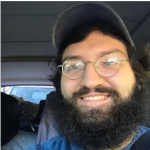 Anthony Vizcaíno Aportela (UC San Diego) graduated with a B.S. in physics with highest honors from Georgia Tech. He is a graduate student, currently part of the Duarte Lab. In collaboration with CMS physicists, he is working on hardware-accelerated machine learning for the detector triggers, as well as geometric deep learning for exotic particle searches. In his free time he likes to bind books and indulge in woodworking. Anthony Vizcaíno Aportela (UC San Diego) graduated with a B.S. in physics with highest honors from Georgia Tech. He is a graduate student, currently part of the Duarte Lab. In collaboration with CMS physicists, he is working on hardware-accelerated machine learning for the detector triggers, as well as geometric deep learning for exotic particle searches. In his free time he likes to bind books and indulge in woodworking.
|
 Jason Corbin (Stanford University) graduated in 2021 with a B.S. in physics from the College of Creative Studies at UC Santa Barbara. He is now a graduate student at Stanford University’s Kavli Institute, working in the Irwin lab. He has built an ultra-high vacuum system of 15 kV electrodes for use in the MAGIS-100 experiment. His future work will be in the area of developing a superconducting SQUID array. Jason Corbin (Stanford University) graduated in 2021 with a B.S. in physics from the College of Creative Studies at UC Santa Barbara. He is now a graduate student at Stanford University’s Kavli Institute, working in the Irwin lab. He has built an ultra-high vacuum system of 15 kV electrodes for use in the MAGIS-100 experiment. His future work will be in the area of developing a superconducting SQUID array.
|
 Gael Flores Avila (UCLA) is a graduate student pursuing research in electronics instrumentation for Trigger and Data Acquisition systems for collider experiments. As part of the HEPCAT fellowship, Gael will design, build, and test a next-generation digital processor featuring an input bandwidth of 15 Tb/s and the largest FPGA ever made. Gael will be trained in board schematics, layout, and FPGA firmware and participate in the CMS group’s activities on the upgrade of the Muon Trigger for High Luminosity LHC. Gael Flores Avila (UCLA) is a graduate student pursuing research in electronics instrumentation for Trigger and Data Acquisition systems for collider experiments. As part of the HEPCAT fellowship, Gael will design, build, and test a next-generation digital processor featuring an input bandwidth of 15 Tb/s and the largest FPGA ever made. Gael will be trained in board schematics, layout, and FPGA firmware and participate in the CMS group’s activities on the upgrade of the Muon Trigger for High Luminosity LHC.
|
 Joseph Levine (UC Davis) is a graduate student in Tony Tyson’s group. He is working on the dark photon search experiment and is helping build a summer school module for the HEPCAT quantum devices topical group. He in interested in instrumentation and has experience in electronics, data acquisition, and COMSOL EM simulation software. Joseph is also active in mentoring K-12 students in STEM. Joseph Levine (UC Davis) is a graduate student in Tony Tyson’s group. He is working on the dark photon search experiment and is helping build a summer school module for the HEPCAT quantum devices topical group. He in interested in instrumentation and has experience in electronics, data acquisition, and COMSOL EM simulation software. Joseph is also active in mentoring K-12 students in STEM.
|
 Adam Molnar (UC Santa Cruz) is a graduate student, who received his bachelor’s degree in Physics and Mathematics at UC Berkeley in 2020. In the following year, he split his time between LBNL and Fermilab. At Fermilab he worked on LGAD characterization using hadronic test beams, while at LBNL he developed a digital characterization platform for pixel sensor data transmission. Adam is currently working on establishing a testbed for ATLAS ITk strip thermo-cycling studies. Adam has a strong interest in instrumentation, particularly related to solid-state sensors and their application as detector elements in next-generation experiments. Adam Molnar (UC Santa Cruz) is a graduate student, who received his bachelor’s degree in Physics and Mathematics at UC Berkeley in 2020. In the following year, he split his time between LBNL and Fermilab. At Fermilab he worked on LGAD characterization using hadronic test beams, while at LBNL he developed a digital characterization platform for pixel sensor data transmission. Adam is currently working on establishing a testbed for ATLAS ITk strip thermo-cycling studies. Adam has a strong interest in instrumentation, particularly related to solid-state sensors and their application as detector elements in next-generation experiments.
|
 Jianyang Qi (UC San Diego) graduated from UCSD with a B.S. in physics and continued his graduate school there in Fall 2020. He is interested in neutrino detection using noble liquid detectors. He is currently involved in the XENONnT experiment, with a focus on the investigation of single electron signals and background relevant to solar neutrino detection. He is also involved in R&D and hardware development towards reactor neutrino detection using noble liquids. In his free time, he likes to freedive and do silk embroidery. Jianyang Qi (UC San Diego) graduated from UCSD with a B.S. in physics and continued his graduate school there in Fall 2020. He is interested in neutrino detection using noble liquid detectors. He is currently involved in the XENONnT experiment, with a focus on the investigation of single electron signals and background relevant to solar neutrino detection. He is also involved in R&D and hardware development towards reactor neutrino detection using noble liquids. In his free time, he likes to freedive and do silk embroidery.
|
 Jacob Sebastian (UC Berkeley) is a graduate student in the nuclear engineering department. He graduated in 2019 from North Carolina State with BS degrees in Mechanical Engineering, Applied Mathematics, and Political Science with a minor in Middle East Studies. He has held positions as an international nuclear safeguards intern at LLNL, a research assistant at the Center for Global Security Research at LLNL, and a Herbert Scoville Jr. Peace Fellow at the Nuclear Threat Initiative. Sebastian’s research project will focus on instrumentation by measuring pulse shapes in high-resolution scintillators for HEP and broader detection communities. Jacob Sebastian (UC Berkeley) is a graduate student in the nuclear engineering department. He graduated in 2019 from North Carolina State with BS degrees in Mechanical Engineering, Applied Mathematics, and Political Science with a minor in Middle East Studies. He has held positions as an international nuclear safeguards intern at LLNL, a research assistant at the Center for Global Security Research at LLNL, and a Herbert Scoville Jr. Peace Fellow at the Nuclear Threat Initiative. Sebastian’s research project will focus on instrumentation by measuring pulse shapes in high-resolution scintillators for HEP and broader detection communities.
|
 Dylan Smith (UC Irvine) is a physics graduate student. He was born and raised in Dearborn, MI, and attended Michigan State University for his B.S. in physics. His current research project uses machine learning to develop generalized calorimeter simulations to help study the performance of future detectors. Outside of research, he enjoys reading (mostly philosophy of science or philosophy in general) and playing video games (his favorite is Legend of Zelda: Breath of the Wild). Dylan Smith (UC Irvine) is a physics graduate student. He was born and raised in Dearborn, MI, and attended Michigan State University for his B.S. in physics. His current research project uses machine learning to develop generalized calorimeter simulations to help study the performance of future detectors. Outside of research, he enjoys reading (mostly philosophy of science or philosophy in general) and playing video games (his favorite is Legend of Zelda: Breath of the Wild).
|
